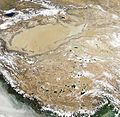File:Jewel-Toned Lakes of the Qinghai-Tibet Plateau.jpg

Size of this preview: ༦༡༥ × ༦༠༠ pixels. Other resolutions: ༢༤༦ × ༢༤༠ pixels | ༤༩༢ × ༤༨༠ pixels | ༧༨༨ × ༧༦༨ pixels | ༡,༠༥༠ × ༡,༠༢༤ pixels | ༢,༡༠༡ × ༢,༠༤༨ pixels | ༧,༩༤༠ × ༧,༧༤༠ pixels.
ཐོག་མའི་ཡིག་ཆ། (༧,༩༤༠ × ༧,༧༤༠ བརྙན་རྒྱུ།, ཡིག་ཆ་ཆེ་ཆུང།: ༧ MB, རྣམ་གཞག།: image/jpeg)
ཡིག་ཆའི་ལོ་རྒྱུས།
ཟླ་ཚེས་/དུས་ཚོད་གནུན་ཏེ་རྩོམ་ཡིག་ལ་ལྟ་བ།
| ཚེས་གྲངས། / དུས་ཚོད། | བསྡུས་དོན། | ཚད། | སྤྱོད་མི། | བསམ་ཚུལ། | |
|---|---|---|---|---|---|
| ད་ལྟ། | ༡༣:༢༢, ༢༦ ཟླ་དང་པོ། ༢༠༡༣ |  | ༧,༩༤༠ × ༧,༧༤༠ (༧ MB) | Slick-o-bot | Bot: convert to a non-interlaced jpeg (see bug #17645) |
| ༡༠:༣༣, ༢༦ ཟླ་བཅུ་གཅིག་པ། ༢༠༡༠ |  | ༧,༩༤༠ × ༧,༧༤༠ (༦.༨༨ MB) | Originalwana | {{Information |Description={{en|1=Natural-colour image of the Tibetan Plateau. The Qinghai-Tibet Plateau not only gives rise to most of Asia’s major rivers, it also holds a constellation of salt- and freshwater lakes. Due to differences in depth |
ཡིག་ཆ་བེད་སྤྱོད་ཁུལ།
pagelinks འདི་ལ་སྦྲེལ་ཡོད།
Global file usage
The following other wikis use this file:
- Usage on ast.wikipedia.org
- Usage on ca.wikipedia.org
- Usage on de.wikipedia.org
- Usage on en.wikipedia.org
- Usage on es.wikipedia.org
- Usage on sl.wikipedia.org
- Usage on sr.wikipedia.org
- Usage on uk.wikipedia.org


